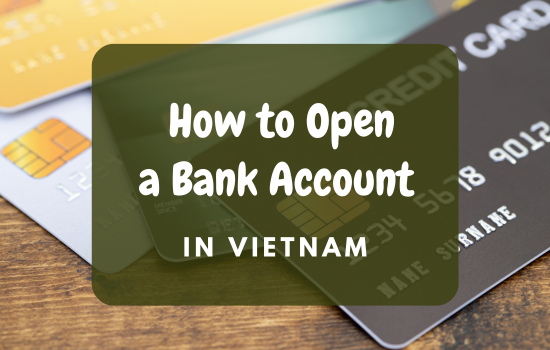


Moving to a new country to teach English can be an exciting adventure, but it also comes with its challenges - one of which is managing your finances. As a foreign teacher in Vietnam, opening a local bank account is essential for receiving your salary, paying bills, and managing your day-to-day expenses. This guide will explain why you need a bank account, choose the right bank, the documents required to make a bank account, the step-by-step process to open a bank account, how to manage your bank account, and how to make banking easy.
1. Why You Need a Bank Account in Vietnam
Before diving into the details of how to open a bank account, it's essential to understand why having a local account is beneficial:
1.1. Receiving Your Salary
Most schools and language centers in Vietnam pay their employees via bank transfer. A local bank account ensures you receive your salary promptly and without international transfer fees.
1.2. Convenience
A local bank account allows you to easily withdraw cash, make payments, and transfer money within Vietnam. It also provides access to online banking and mobile payment services, which are becoming increasingly popular in the country.
1.3. Currency Management
With a Vietnamese bank account, you can hold funds in Vietnamese Dong (VND), the local currency, making it easier to manage your finances without worrying about exchange rates.
1.4. Savings and Investments
Some banks offer savings accounts with competitive interest rates and investment options tailored to expatriates, allowing you to grow your savings while living in Vietnam.
2. Choosing the Right Bank
Vietnam has a wide range of local and international banks to choose from. Your chosen bank will depend on your personal preferences, location, and banking needs. Here’s an overview of some of the best options for foreign teachers:
2.1. Local Banks
2.2. International Banks
2.3. Considerations for Choosing a Bank
3. Documents Required to Open a Bank Account
To open a bank account in Vietnam, you must provide several documents. The exact requirements may vary slightly depending on the bank, but generally, you will need the following:
3.1. Passport
Your passport is the primary form of identification required. It should be valid for at least six months before expiration. Banks will typically make a copy of your passport photo page and the page containing your Vietnamese visa.
3.2. Vietnamese Visa
A valid visa is essential. Most banks require a business or work visa, though some may accept other types of long-term visas, such as a tourist visa, if you have a valid reason for needing an account.
3.3. Proof of Address
You will need to provide proof of your local address in Vietnam. Acceptable documents include:
3.4. Work Permit or Employment Contract
While not always required, having a work permit or employment contract can facilitate the process. Some banks may request proof of employment, mainly if you’re opening an account to receive your salary.
3.5. Initial Deposit
Some banks require an initial deposit to open an account. This amount varies but is generally low, typically ranging from 100,000 VND to 500,000 VND (approximately $4 to $20 USD).
3.6. Additional Documents
Depending on the bank, you may also need to provide additional documents, such as:
4. Step-by-Step Process to Open a Bank Account
Once you’ve chosen your bank and gathered the necessary documents, follow these steps to open your account:
4.1. Visit the Bank
Go to the branch of your chosen bank during business hours. It’s advisable to visit in the morning when banks are less busy. Some banks offer the option to make an appointment in advance.
4.2. Submit Your Documents
Provide the bank staff with your passport, visa, address proof, and other required documents. The staff will review your documents and help you complete any necessary forms.
4.3. Choose an Account Type
Decide on the type of account you want to open. Common options include:
4.4. Make an Initial Deposit
If required, make your initial deposit to activate the account. This deposit can usually be made in cash or by transferring funds from another account.
4.5. Receive Your Banking Materials
Once your account is set up, you’ll receive your account details, debit card, and any necessary PIN codes. Some banks provide the card immediately, while others may require you to return it in a few days to collect it.
4.6. Set Up Online and Mobile Banking
Most banks in Vietnam offer online and mobile banking services. The bank staff will guide you through setting up these services, which typically involve creating a username and password and downloading a mobile app.
4.7. Activate Your Account
Before using your account, you may need to activate it by making a transaction or verifying your identity through a phone call or email.
5. Conclusion: Making Banking Easy in Vietnam
Opening a bank account as a foreign teacher in Vietnam is straightforward, provided you have the necessary documents and choose the right bank for your needs. Whether managing your salary, paying bills, or saving for the future, having a local bank account will simplify your financial life in Vietnam.
By following the steps outlined in this guide and being aware of the local banking practices, you can easily navigate the process and enjoy the benefits of financial stability while teaching in this country. With the proper preparation, managing your money in Vietnam will be as rewarding as your teaching experience.
If you need more tips to live in Vietnam, you can follow these links:
How to Change the Location on Grab to Book a Ride
Understanding Vietnamese Customs and Etiquette
How Different is the Lifestyle in North, Central, and South Vietnam?
How to book Grab as a foreigner
Is Vietnam safe for foreigners? 2024 updated
Learning Vietnamese for Beginners with Chat GPT for Free
Culture shocks you might have when teaching English in VietNam
Copyright © 2024.Company name All rights reserved.